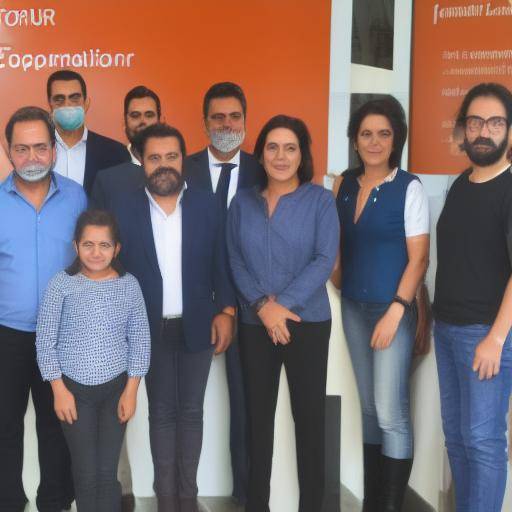
The integration of students with special needs in the field of education is a primary task for ensuring the equity and integral development of each individual. In this article, we will explore the importance of integration, special needs, and effective strategies to ensure an inclusive and enriching educational environment. From its historical evolution to future trends, this content offers an exhaustive vision that seeks to inform, inspire and enhance concrete actions in favour of educational integration.
Introduction
The integration of students with special needs has become a central theme in the educational field, as it represents a commitment to equal opportunities and social justice. Strategies to ensure effective integration are critical to building an inclusive and respectful society of diversity. Throughout this article, we will explore the different facets of this challenge, from its historical evolution to future trends and perspectives.
History and Background
The educational integration of students with special needs has its historical roots in movements for social and educational inclusion. Over the years, this area has experienced significant progress, arising as a result of the struggle for the rights of persons with disabilities. From the creation of special schools to the gradual incorporation into regular educational environments, the evolution of this process has been marked by important milestones that reflect a significant change in the conception of inclusive education.
A key turning point in recent history of educational integration was the Salamanca Declaration in 1994, which promoted inclusive education as a fundamental right of all children, regardless of their abilities. This event marked a milestone in the global recognition of the importance of integration and the need to develop strategies that ensure the equal participation of all students in the education system.
Analysis in Deep
The importance of educational integration lies in the benefits of both students with special needs and the community as a whole. The creation of inclusive educational environments not only promotes equal opportunities, but also fosters understanding, respect and empathy among members of the school community. However, this company is not without challenges, as effective implementation of integration strategies requires a strong commitment on the part of educational institutions and society at large.
The detailed analysis of the current challenges in terms of educational integration gives us a precise view of the barriers that still need to be overcome. Lack of resources, resistance to inclusion and the need for curricular adaptations represent significant obstacles to be addressed through effective and sustainable strategies to ensure the full development of students with special needs.
Comprehensive review
The implementation of successful strategies for the integration of students with special needs involves identifying and applying best practices in the field of education. The comprehensive analysis of these practices allows us to understand the multifaceted nature of integration, highlighting the importance of addressing the individual needs of each student from personalized and flexible approaches.
Compare different methods and approaches allows us to identify those strategies that have proven to be more effective, as well as those that still require development and improvement. This comparative analysis gives us a clear picture of the opportunities and challenges associated with educational integration, providing a solid basis for the implementation of innovative and effective strategies.
Practical Tips and Accessible Instructions
Aligning educational strategies with the specific needs of students involves the implementation of clear practical advice and guidelines that can be successfully applied in diverse educational settings. The creation of plans for inclusion, adaptation of teaching materials and the promotion of an environment of respect and understanding are fundamental aspects to be considered. These practices, supported by evidence and successful experiences, form a set of tools that can be implemented in different educational contexts, promoting the effective integration of students with special needs.
Industrial Perspectives and Expert Reviews
The analysis of the perspectives and opinions of experts in the field of educational integration gives us an enriching view of current trends, as well as future projections regarding strategies that best promote effective inclusion. Collaboration with educational professionals and specialists in special needs is an invaluable source of knowledge and experience, enriching the implementation of strategies at the individual and institutional level.
Case Studies and Practical Applications
Case studies presenting practical applications of educational integration strategies are an essential tool for understanding the real impact of such strategies on the development and well-being of students. These examples, from different educational environments and cultural contexts, offer a detailed view of the results obtained, as well as lessons learned that can be extrapolated to various educational realities.
Future Trends and Predictions
Exploring emerging trends related to the integration of students with special needs allows us to project future scenarios and potential challenges that require attention and action. Current data analysis, complemented by feedback from experts in the field, gives us an informed perspective on key areas that will require focus and development to promote effective educational integration in the future.
Conclusion
The integration of students with special needs in educational settings represents an inescapable commitment to equity, justice and respect for diversity. Through this article, we have explored the historical, present and future importance of this process, as well as the strategies that best guarantee effective and meaningful integration. In view of the challenges and opportunities that this field presents, it is essential to take an active commitment to the implementation of inclusive strategies that promote the full development of each student, regardless of their individual needs.
Frequently asked questions
What are the benefits of integrating students with special needs?
Educational integration provides benefits for both students with special needs and their peers, such as promoting empathy, diversity of skills and developing an inclusive sense of community.
What are the most common challenges associated with integrating students with special needs?
Challenges include lack of resources, resistance to inclusion, the need for curricular adaptations and the development of individualized support strategies.
What are some effective strategies for educational integration?
Effective strategies include the creation of inclusion plans, the adaptation of teaching materials, the promotion of an environment of respect and understanding, and the training of teachers in educational inclusion.
What are future trends in integrating students with special needs?
Increased attention is being paid to inclusion in educational settings, as well as the development of new technologies and tools to support the integration of students with special needs.
What is the role of teachers in integrating students with special needs?
Teachers play a crucial role in implementing integration strategies, including identifying individual needs, adapting educational methodologies and promoting an inclusive environment.
How can the educational community support the integration of students with special needs?
The educational community can support the integration of students with special needs through the promotion of empathy, awareness of individual needs, and the implementation of inclusive policies and practices that encourage the equal participation of all students.
In short, the integration of students with special needs in educational settings represents a commitment to equity, justice and respect for diversity. Through effective strategies and an active commitment, it is possible to ensure an educational environment in which each student has the opportunity to fully develop, regardless of their individual needs. This integration process requires a holistic, collaborative and sustainable approach that recognizes the importance of diversity and promotes an inclusive educational environment for all.
With the knowledge and tools presented in this article, it is hoped that readers will be better equipped to address and promote the educational integration of students with special needs in their respective environments, thus promoting a positive and lasting change in inclusive education.
FAQ
- What are the benefits of integrating students with special needs?
- Educational integration provides benefits for both students with special needs and their peers, such as promoting empathy, diversity of skills and developing an inclusive sense of community.
- What are the most common challenges associated with integrating students with special needs?
- Challenges include lack of resources, resistance to inclusion, the need for curricular adaptations and the development of individualized support strategies.
- What are some effective strategies for educational integration?
- Effective strategies include the creation of inclusion plans, the adaptation of teaching materials, the promotion of an environment of respect and understanding, and the training of teachers in educational inclusion.
- What are future trends in integrating students with special needs?
- Increased attention is being paid to inclusion in educational settings, as well as the development of new technologies and tools to support the integration of students with special needs.
- What is the role of teachers in integrating students with special needs?
- Teachers play a crucial role in implementing integration strategies, including identifying individual needs, adapting educational methodologies and promoting an inclusive environment.
- How can the educational community support the integration of students with special needs?
- The educational community can support the integration of students with special needs through the promotion of empathy, awareness of individual needs, and the implementation of inclusive policies and practices that encourage the equal participation of all students.
With answers to these frequent questions, it is expected to provide a more comprehensive and concrete understanding of the educational integration of students with special needs, which will enable readers to address this crucial issue with greater clarity and confidence.
This article, by offering a panoramic and detailed view of the educational integration of students with special needs, seeks to inspire, inform, and empower readers, while placing integration strategies as fundamental pillars of inclusive and equitable education.






















































